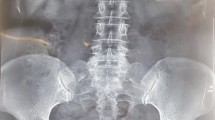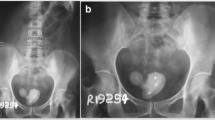Abstract
The study aimed to present diagnosis and management of urinary complications resulting from migration of intrauterine contraceptive device (IUD). Between May 2002 and January 2007, eight women were treated for urinary complications because of migrated IUD. Persistent lower urinary tract symptoms were the main complaint in five cases, while one patient presented with urinary incontinence and two had suffered from right loin pain. Diagnosis was established after performing noncontrast computed tomography (NCCT) in all cases. Intravenous urogram (IVU) was carried out for evaluation of hydronephrosis in two cases. Cystoscopy was performed before surgical intervention in six cases. The interval between insertion of IUD and onset of symptoms ranged from 1 week up to 2 years. NCCT revealed complete intravesical position of the IUD with calculus formation on top in four cases and partial bladder wall penetration in the fifth. Cystoscopy confirmed the site of the IUD as detected by NCCT. In the last two cases, retroperitoneal migration of IUD had led to fibrosis around the right pelvic ureter. Intravesical IUDs and stones were successfully retrieved using transurethral endoscopy while suprapubic retrieval of the device was followed by repair of vesicouterine fistula in the fifth case and ureteroneocystostomy in the last two cases. Persistent lower urinary tract symptoms in women with IUD should raise the suspicion of intravesical migration. Noncontrast CT permitted excellent depiction of the site of migrated IUD for selection of proper management. Endoscopic retrieval is feasible and safe in cases with intravesical migrated IUD.






Similar content being viewed by others
References
Oruc S, Vatansever HS, Karaer O, Eskicioglu F, Narlikuyu B (2005) Changes in distribution patterns of integrins in endometrium in copper T380 intrauterine device users. Acta Histochem 107:95–103
Tuncay YA, Tuncay E, Guzin K, Ozturk D, Omurcan C, Yucel N (2004) Transuterine migration as a complication of intrauterine contraceptive devices: six case reports. Eur J Contracept Reprod Health Care 9:194–200
Thomalla JV (1986) Perforation of urinary bladder by intrauterine device. Urology 27:260–264
EL-Diasty TA, Shokeir AA, El-Gharib MS, Sherif LS, Shamaa MA (1993) Bladder stone: a complication of intravesical migration of Lippes loop. Scand J Urol Nephrol 27:279–280
Ozcelik B, Serin IS, Basbug M, Aygen E, Elmekcioglu O (2003) Differential diagnosis of intrauterine device migrating to bladder using radiographic image of calculus formation and review of literature. Eur J Obstet Gynecol Reprod Biol 108:94–97
Ohana E, Sheiner E, Leron E, Mazor M (2000) Appendix perforation by an intrauterine contraceptive device. Eur J Obstet Gynecol Reprod Biol 88:129–131
Markovitch O, Klein Z, Gidoni Y, Holzinger M, Beyth Y (2002) Extrauterine mislocated IUD: Is surgical removal mandatory? Contraception 66:105–108
McWhinney NA, Jarrett R (1983) Uterine perforation by a Copper T intrauterine contraceptive device with subsequent penetration of the appendix. Case report. Br J Obstet Gynaecol 90:774–776
Maskey CP, Rahman M, Sigdar TK, Johnsen R (1997) Vesical calculus around an intra-uterine contraceptive device. Br J Urol 79:654–655
Caliskan E, Ozturk N, Dilbaz BO, Dilbaz S (2003) Analysis of risk factors associated with uterine perforation by intrauterine devices. Eur J Contracept Reprod Health Care 8:150–155
Heartwell SF, Schlesselman S (1983) Risk of uterine perforation among users of intrauterine devices. Obstet Gynecol 61:31–35
Eke N, Okpani AO (2003) Extrauterine translocated contraceptive device: a presentation of five cases and revisit of the enigmatic issues of iatrogenic perforation and migration. Afr J Reprod Health 7:117–123
Dietrick DD, Issa MM, Kabalin JN, Bassett JB (1992) Intravesical migration of intrauterine device. J Urol 147:132–134
Zakin D (1984) Perforation of the bladder by the intrauterine device. Obstet Gynecol Surv 39:59–66
Sepulveda WH, Ciuffardi I, Olivari A, Gallegos O (1993) Sonographic diagnosis of bladder perforation by an intrauterine device. A case report. J Reprod Med 38:911–913
Caspi B, Rabinerson D, Appelman Z, Kaplan B (1996) Penetration of the bladder by a perforating intrauterine contraceptive device: a sonographic diagnosis. Ultrasound Obstet Gynecol 7:458–460
Kudo N, Yoshida M, Yamamoto K, Mikami T, Kitabatake A, Ito Y (1998) Basic study on ultrasound attenuation of fibrous biological tissue. IEEE Ultrasonic Symposium 1497–1482
Saricaka SA, Bayram M (2000) Ureteral displacement due to a migration of intrauterine contraceptive device. Urol Int 65:179–180
McKenna PJ, Mylotte MJ (1982) Laparoscopic removal of translocated intrauterine contraceptives devices. Br J Obstet Gynaecol 89:163–165
Author information
Authors and Affiliations
Corresponding author
Rights and permissions
About this article
Cite this article
El-Hefnawy, A.S., El-Nahas, A.R., Osman, Y. et al. Urinary complications of migrated intrauterine contraceptive device. Int Urogynecol J 19, 241–245 (2008). https://doi.org/10.1007/s00192-007-0413-x
Received:
Accepted:
Published:
Issue Date:
DOI: https://doi.org/10.1007/s00192-007-0413-x




